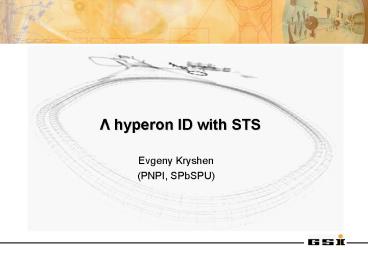hyperon ID with STS PowerPoint PPT Presentation
1 / 27
Title: hyperon ID with STS
1
? hyperon ID with STS
- Evgeny Kryshen
- (PNPI, SPbSPU)
2
Simulation framework
- Central Au-Au collisions at 25 AGeV
- UrQMD generator
- Geant3 transport
- No magnetic field applied fitting tracks with
straight lines - STS resolution 10 µm
- Resolution on momentum reconstruction 1
- Statistics up to 20 000 events
3
Hyperons Table
4
Initial distributions for primary ?
- Definition of acceptance hits at least in 4 STS
stations for daughters - from the 4th (40cm) to the 7th STS station
(100cm) - Charged decay channel is considered (BR63.9)
? ? p p -
5
Acceptance for primary ?
Total acceptance 39.7 (primary 42.8,
secondary 32.9)
6
Initial invariant mass distribution
- Fit gaus 2-order polynomial
- 1 momentum resolutionresults in s 0.8 MeV/c2
- Signal and background are calculated in the range
of 2s - Initital S/B ratio 0.046
7
Applying cuts
- The following variables were considered to cut
the background - bpp protons and p- impact parameter
- pca z position of secondary vertex
- dca distance of closest approach
- bla impact parameter of pair momentum
- ang pointing angle
- mtr transverse momentum of ? daughters
8
Illustration of cut parameters
9
Illustration of pair impact parameter cut
10
Impact parameter cut (bpp)
Primary ?
Secondary ?
Primary protons
Primary protons
Backgroundprotons
Backgroundprotons
Signal protons
Signal protons
11
Z-vertex cut (pca)
Primary ?
Secondary ?
Pairs from primary vertex
Pairs from primary vertex
All pairs
All pairs
Signal pairs
Signal pairs
12
Distance of closest approach (dca)
Primary ?
Secondary ?
All pairs
All pairs
Signal
Signal
13
Pair impact parameter (bla)
Primary ?
Secondary ?
All pairs
All pairs
Signal pairs
Signal pairs
14
Analysis for the impact parameter cut
Cut value 0.1 cm
- Total efficiency
- all ? 77
- primary ? 76
- secondary ? 79
- S/B ratio 1.05
- Significance 1.88
15
Selection of the optimal cut value
Cut variable impact parameter of p and p-
Maximum significance is achieved at cut value of
0.1 cm
Significance 1.88
S/B ratio 1.05
Efficiency (prim) 0.76
Efficiency (sec) 0.79
16
Comparative table of cut parameters
Conclusion impact parameter cut is the strongest
one, should be applied first.
17
Results of cut mixing
Conclusion bppbla cut should be used for
background subtraction
18
Efficiency and invariant mass distributionfor
the selected set of cuts
Cut values bpp 0.1 cm, bla 0.03 cm
- Total efficiency
- all ? 65
- primary ? 69
- secondary ? 59
- S/B ratio 208
- Significance 2.55
19
Analysis for the impact parameter cut
Cut value 0.1 cm
- Total efficiency
- all ? 77
- primary ? 76
- secondary ? 79
- S/B ratio 1.05
- Significance 1.88
20
Reconstruction of initial distributions
Signal
Efficiency
Acceptance
Signal is reconstructed in a bin-by-bin
basis rapidity 20 bins (step 0.2) pT
25 bins (step 0.1 GeV/c)
Statistics 20 000 events
21
Reconstruction of initial distributions
Corrected signal
Initial distribution
22
Reconstructed pT distributions
y 0.8 1.0
y 1.8 2.0
Reconstructed signal
Fitting function
23
Reconstructed rapidity spectrum
24
Conclusions
- Cuts allow to reconstruct ? signal almost without
background - Satisfying reproduction of the input
- Good coverage in pT and rapidity
- Reconstructed yield 35.17 vs initial yield 40.48
(all ?) - Acceptance and efficiency maps can be used in the
future to reconstruct experimental spectra (at
least in principle) - CbmLambdaTask has been developed it can be used
to analyse other two-body decays (including ? and
O hyperons)
25
Future steps
- Estimation of errors
- Estimation of TOF acceptance for ? decay products
- ? analysis without particle ID (all positive vs
all negative) - ? analysis with magnetic field applied(track
reconstruction tool is under development) - Analysis of ? and O hyperons
- Your suggestions
26
Acknowledgements
- To Drs V. Friese and P. Senger
- for their help, support and advice
- To Dr J. Knoll and H. Rinnert
- for the great opportunity to be a Summer Student
at GSI
27
- Thank you for your attention

